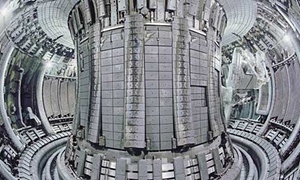
 Iter, the next fusion machine and the first to be built as an international collaboration, is designed to demonstrate the scientific feasibility of net energy production. It is expected that Iter will produce about 500MW of fusion power – 10 times the input power. Just as importantly, it will show how to integrate the many cutting-edge technologies required for efficient and reliable future power station designs. Put simply, it is the big step needed to prove the viability of fusion as a commercial energy source.
Iter, the next fusion machine and the first to be built as an international collaboration, is designed to demonstrate the scientific feasibility of net energy production. It is expected that Iter will produce about 500MW of fusion power – 10 times the input power. Just as importantly, it will show how to integrate the many cutting-edge technologies required for efficient and reliable future power station designs. Put simply, it is the big step needed to prove the viability of fusion as a commercial energy source.
Unfortunately, Iter's construction expenses have risen from about €5bn to over €13bn and the cost overruns have prompted some to question why chasing nuclear fusion is a priority. How sure are we that Iter will work? Could this money be spent more wisely in other areas of energy research, such as renewables or new fission? My answer is that fusion is more than desirable. It may be crucially necessary.
Burning coal, oil, or natural gas generates 80% of the world's primary energy. This simply can't continue much longer. Fossil fuels are diminishing resources, and burning them adversely affects climate and the environment. If we ask what energy sources could take over the role of fossil fuels, there are only three candidates with sufficient long-term resource: solar, nuclear fission with uranium or thorium breeders and nuclear fusion. Other sources will play important but lesser roles, for example wind may provide 10-20% of energy supply.
All three long-term options require substantial research and development before they are ready, or cheap enough, to be deployed on a large scale. None are certain to deliver everything so it would be foolish not to fund research on all three.
How likely is Iter's success? To make fusion we must heat a very hot gas (or plasma) of hydrogen-like fuels to temperatures 10 times those at the centre of the sun (100-200m degrees C) and hold it in place in a containment vessel using powerful magnetic fields. Experiments at the Joint European Torus (Jet) in the UK regularly achieve such conditions. Indeed Jet has produced 16MW of fusion power. So fusion works. Sophisticated computer simulations and empirical extrapolations from Jet and other machines predict that Iter will reach and perhaps exceed its target performance. If this is true then we could see following Iter with the first electricity-producing prototype fusion reactor by the end of the 2030s.
Is Iter worth the increased cost? Iter has to be large and technically advanced – and that comes with a big bill. Of the €13bn price tag (over 10 years), Europe, as host of Iter, pays 45% (around €6bn). The cost overrun in 2011/2013 will be €1.4bn. It has now been decided to redeploy funds to cover the gap from the overall European research budget.
For a commodity so vital to the way we live our lives, the €10bn spent yearly by the public sector worldwide on energy research is pitifully low – about 0.2% of the approximately €5tn world energy market. Compare this with the $20bn (€15.5bn) that BP has set aside to deal with all aspects of the Gulf oil spill. With this perspective Iter's cost seems appropriate. I would argue that the ultimate prize of commercial fusion power makes Iter a project well worth pursuing. Indeed, I would advocate increases in all areas of energy research worldwide, including renewables and fission.
YOU MIGHT ALSO LIKE












